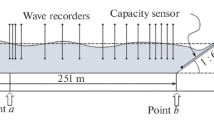Abstract
The role of bottom friction in the runup of nonbreaking long waves on the shore is analyzed. The case of the normal incidence of monochromatic waves is considered. The relief of the model region consists of an even horizontal bottom area conjugated with a flat slope. The energy dissipation is estimated as the work of bottom friction forces over the wave field obtained using the known analytical solution based on the Carrier-Greenspan transforms. Estimates of energy losses for waves whose periods are typical for tsunami waves have been obtained. The energy dissipation is shown to be not concentrated in the shore line area as a rule. The question about the practicability of using partially reflecting boundary conditions on the coast to take into account the bottom friction in large-scale models of tsunami propagation is considered.
Similar content being viewed by others
References
A. V. Bernatskii and M. A. Nosov, “Setting Boundary Conditions on the Coastline in the Numerical Modeling of Tsunami Waves,” in Natural Disasters: Study, Monitoring, and Prediction: The Third Sakhalin Youth Scientific School, Yuzhno-Sakhalinsk, June 3–6, 2008, Ed. by O. N. Likhacheva (Institute of Marine Geology and Geophysics, Yuzhno-Sakhalinsk, 2009), pp. 130–136 [in Russian].
L. D. Landau and E. M. Lifshits, Hydrodynamics (Nauka, Moscow, 1986) [in Russia].
B. V. Levin and M. A. Nosov, Physics of Tsunami (Yanus-K, Moscow, 2005) [in Russian].
A. V. Nekrasov, “On the Reflection of Tidal Waves from Shelf Zone,” Okeanologiya 13(2), 210–215 (1973).
E. N. Pelinovskii, Hydrodynamics of Tsunami Waves (Institute of Applied Physics, Ras, Nizhny Novgorod, 1996) [in Russian].
G. Carrier and H. Greenspan, “Water Waves of Finite Amplitude on a Sloping Beach,” J. Fluid Mech. 4, 97–109 (1958).
Y. Li and F. Raichlen, “Non-Breaking and Breaking Solitary Wave Run-Up,” J. Fluid Mech. 456, 295–318 (2002).
R. Kh. Mazova, N. N. Osipenko, and E. N. Pelinovsky, “Solitary Wave Climbing a Beach Without Breaking,” Rozprawy Hydrotechniczne, No. 54, 71–80 (1991).
S. Tinti, G. Pagnoni, and F. Zaniboni, “The Landslides and Tsunamis of the 30th of December 2002 in Stromboli Analysed through Numerical Simulations,” Bull. Vulcanol. 68, 462–479 (2005).
Author information
Authors and Affiliations
Corresponding author
Additional information
Original Russian Text © A.V. Bernatskiy, M.A. Nosov, 2012, published in Izvestiya AN. Fizika Atmosfery i Okeana, 2012, Vol. 48, No. 4, pp. 481–486.
Rights and permissions
About this article
Cite this article
Bernatskiy, A.V., Nosov, M.A. The role of bottom friction in models of nonbreaking tsunami wave runup on the shore. Izv. Atmos. Ocean. Phys. 48, 427–431 (2012). https://doi.org/10.1134/S0001433812040032
Received:
Accepted:
Published:
Issue Date:
DOI: https://doi.org/10.1134/S0001433812040032




